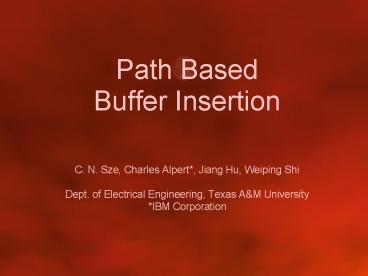Path Based Buffer Insertion - PowerPoint PPT Presentation
1 / 23
Title:
Path Based Buffer Insertion
Description:
CPU time/s. path based. net based. 20. Results - with Buffer Blockages ... Buffer insertion in a more elaborated manner. Propose a path based buffer insertion approach ... – PowerPoint PPT presentation
Number of Views:77
Avg rating:3.0/5.0
Title: Path Based Buffer Insertion
1
Path Based Buffer Insertion
- C. N. Sze, Charles Alpert, Jiang Hu, Weiping Shi
- Dept. of Electrical Engineering, Texas AM
University - IBM Corporation
2
Outline
- Introduction
- The problem
- How buffers are inserted for large circuits
- Algorithm details
- Buffer aware static timing analysis (STA)
- Definition of a path
- Off-path required arrival time (RAT) estimation
- Simultaneous buffer insertion and gate sizing
- Experimental results
- Conclusion
3
Introduction
- Prediction from Intel Saxena et al. TCAD04
- The distance between buffers shrinks rapidly
4
Introduction (2)
Saxena, et al. TCAD 2004
- Buffer insertion and sizing is one of the most
effective method for reducing interconnect delay
5
Previous Works
- Net based buffer insertion
- van Ginneken dynamic programming algorithm
framework (VGDP) ISCAS 90 - Delay minimization based on Elmore delay
- Minimize power (buffer cost) with timing
constraint and consider buffer library ICCAD 95 - Noise avoidance DAC 98
- Higher-order delay model DAC 99
- On-chip inductance DAC 99
- VERY FLEXIBLE!!
- (blockages, invertors/polarity )
6
How Buffers are Inserted?
- Buffer Insertion for large circuits
- Minimize buffer area/power subject to timing
constraint - Apply net based buffer insertion
- Pick a net n1 along critical path
- Insert buffers on n1
- Pick another net n2 and continue
- Repeat until timing constraint is satisfied
7
Whats Wrong with Net Based?
net A
net B
S1
8
Possible Solutions
- Network Based Buffer Insertion
- (Liu,Aziz,Wong,Zhou ICCD99,DATE00)
- Based on Lagrangian relaxation and local
refinement - Assume that buffers are inserted at all branches
- The runtime of the algorithms scale badly
- Path Based Buffer Insertion (PBBI)
- Directly apply VGDP algorithm
- Can be extended to handle complicated practical
problems (e.g. accurate delay model, noise ) - Runtime scales much better
9
Comparison
- CPU runtime
network based
PBBI
net based
Buffer resource efficiency
PBBI
network based
net based
- - assumptions
- difficult to handle
- practical problems
10
Overview of PBBI
- Buffer aware critical path analysis (STA engine)
- From a path to a tree
- Off-Path RAT estimation
- Distinct paths
tree1
Critical path1
Critical path2
tree2
11
Finding Critical Paths
- Traditional static timing analysis is inadequate
- Buffering significantly affects delay on
interconnect - Buffer blockages
- Neglecting buffers may cause inaccurate
estimation of critical paths - In our implementation
- Linear time delay estimation of buffered
interconnect ICCAD04
12
Buffer Insertion For a Path
- Merged trees
- Gate special buffer candidate must added /
fixed size - Bigger trees
- Buffer insertion speedup techniques ASPDAC 05
special buffer candidate
tree1b
tree1c
tree1a
Critical path1
tree1d
13
Off-Path RAT Estimation
- Input of VGDP algorithm
- RAT at sinks
- Buffer solution can affect RAT estimation
Critical path1
14
Off-Path RAT Estimation (2)
- Slack distributed along the path
z
a
i
15
PBBI and Gate Sizing
- Integrating gate sizing into path based buffer
insertion is straight-forward - Sizing up a gate
- Decrease downstream interconnect delay
- Increase upstream interconnect delay
- Gate sizing at sinks gives more control
- Example
16
PBBI and Gate Sizing (2)
- Gate sizing at sinks
- Adjust RAT in order to compensate the increase in
downstream delay
Wire capacitance of one optimal buffer interval
Output resistance of original gate
17
Experiment Setting
- 12 combinational circuits
- Randomly generated from IBM real nets
- Buffer blockages from real layout
- 4 types of buffers (inverted/non-inverted)
- Buffer insertion considers both slew/cap
violations and timing
18
Experimental Results
- Timing constraints
- Find min-delay buffer insertion solution
- Set RAT such that worst-slack 0
- PBBI uses 15 less buffer resource than net
based
19
Experimental Results (2)
- PBBI uses 5x more CPU time
- CPU time is on general empirically linear to
the size of the circuit and the buffer candidate
locations - Buffering for the largest circuit in 40 sec
20
Results - with Buffer Blockages
- Same timing constraints setting
- PBBI uses 29 less buffer resource than net
based - CPU time usage is similar
21
Results PBBI Gate Sizing
- Same setting for timing constraints
- PBBIGS uses 71 less area than net based
- Total CPU time for PBBIGS is 7 minutes
- Path based buffer insertion works very well with
gate sizing
22
Conclusion
- Increasingly more buffers in circuit designs
- Buffer insertion in a more elaborated manner
- Propose a path based buffer insertion approach
- Obtain a better buffer usage efficiency due to
its global view - Our approach is more practical in terms of CPU
runtime and flexibility when comparing to network
based methods - Reduce buffer area by 29
- Includes all buffer counts
- With buffer blockages on the layout
- Reduce buffer/gate cost by 71 on average
23
Thank you
- Questions?































